Tuesday, April 30, 2019
Old Facebook finally wants you to ‘Meet New Friends’
Facebook’s social graph is aging, full of long-lost acquaintances and hometown friends you don’t care much about seeing in the News Feed any more. But Facebook is now testing a pivot away from its core identity of connecting you with existing friends so it can revitalize the social graph and keep people coming back. Facebook’s “Meet New Friends” lets you browse people from shared communities such as your school, workplace or city who’ve also opted in to the feature. It’s now in testing in a few markets before it’s rolled out more widely soon.
Meet New Friends could give people fresh pals to follow in their News Feed, or help recently registered users grow their network until they have access to enough content to keep them busy. And eventually, Facebook could layer on monetization features similar to dating apps where users pay to be shown more prominently to potential connections.
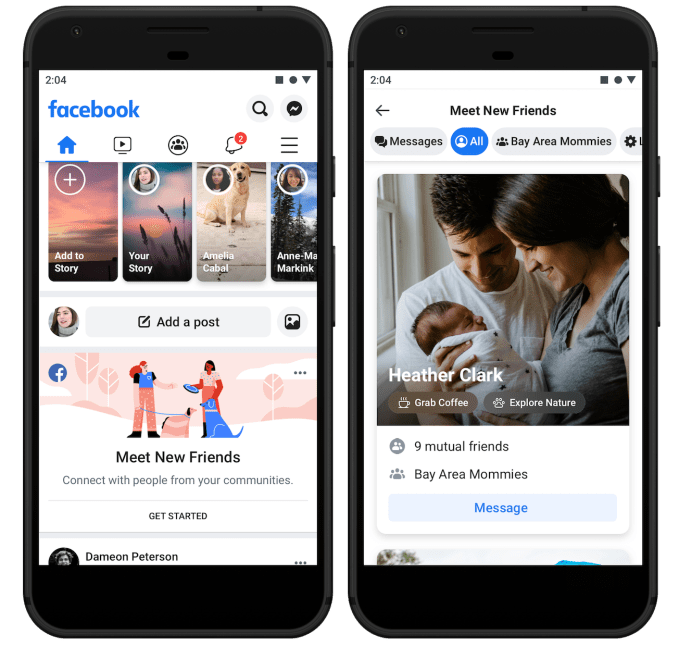
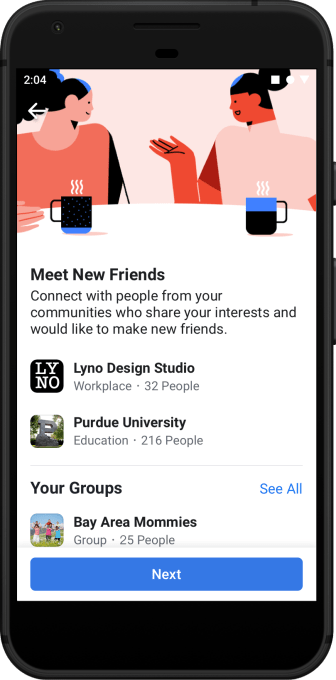 Fidji Simo, the head of Facebook’s main app, tells me Meet New Friends was based on emerging behaviors the company had spotted. “Developing relationships with people they didn’t already know is very different from the core use case of Facebook,” but she notes, “We’ve already seen that naturally happen in Groups, and Meet New Friends will make that a bit easier.”
Fidji Simo, the head of Facebook’s main app, tells me Meet New Friends was based on emerging behaviors the company had spotted. “Developing relationships with people they didn’t already know is very different from the core use case of Facebook,” but she notes, “We’ve already seen that naturally happen in Groups, and Meet New Friends will make that a bit easier.”
When users open Meet New Friends, they pick the communities through which they’re open to meeting new friends. For now they choose between schools, employers and locations, but Facebook will eventually add Groups too. In that sense it works a bit like Facebook Dating, which rolls out to 14 new countries today and opens to dating friends with its new Secret Crush feature.
Algorithms will sort potential connections by who is most relevant, such as those with mutual friends or shared interests, but you won’t get “matched” where both users have to state their interest in the other. Instead, users can just browse profiles, and then either send people a friend request (which might feel a bit out of the blue), or send them a single text-only message to a recipient’s dedicated Meet New Friends chat inbox. They can’t message that same person again until they respond (to prevent spamming), and the text-only limitation ensures no unsavory photos get blasted around. If they do reply, the thread moves to Facebook Messenger.
Meet New Friends will pit Facebook against a range of other apps, from local-focused Meetup and Nextdoor to verticalized apps like Hey Vina for women only to dating-affiliated apps like Bumble BFF. But Facebook benefits from its ubiquity, so users can try Meet New Friends without feeling embarrassed by downloading an app just to make them less lonely.
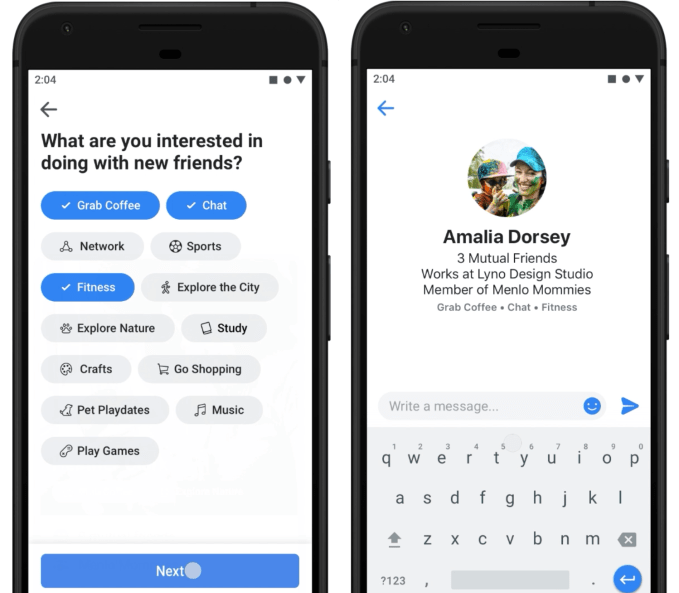
For years, the mildly creepy People You May Know feature has been a cornerstone of Facebook’s growth strategy. But it’s still just about recreating your offline social graph online. As Facebook strives to become more meaningful to people’s lives, fostering new friendships could give people a fuzzy feeling about the giant corporation.
from RSSMix.com Mix ID 8176981 https://techcrunch.com/2019/04/30/facebook-meet-new-friends/
http://www.gadgetscompared.com
from Tumblr https://ikonografico.tumblr.com/post/184557313586
via http://www.gadgetscompared.com
Facebook Dating opens to friends with Secret Crush
Facebook built Dating to be privacy-safe, hoping to avoid the awkwardness of friends or family checking out your romance profile. But now Facebook has found a way to let you silently express your affection for a friend without them knowing unless they reciprocate.
Facebook Dating is opening in 14 more countries, bringing the total to 19. It will launch in the US before the end of the year. Dating brings with it a new feature called Secret Crush that expands it beyond strangers and friends-of-friends. Choose up to 9 friends you like-like. If they’ve opted into Facebook Dating, they’ll get a notification that some friend has a crush on them. If they add you as a Secret Crush too, you’re both notified and can chat on Messenger.
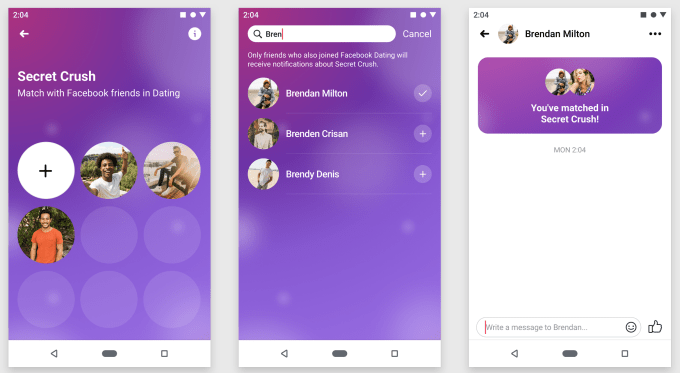
Facebook Dating product manager Charmaine Hung tells me that “I have 2000 Facebook friends. I’m not best friends with all 2000 people, and there’s a good chance that one of that could be a really good match with me. I trust them, I appreciate them, and I know we’re compatible. The only thing missing is knowing if we’re both interested in being more than just friends without the fear of rejection if you were to do this in real life.”
Facebook announced Dating at F8 a year ago and launched it in Colombia in September. Users opt-in, and then browse Events and Groups they’re part of for potential matches. They send them a text-only message based on something in their profile which goes to a special Dating inbox. And if that person reciprocates, they can chat and maybe meet up. Now it’s opening in the Philippines, Vietnam, Singapore, Malaysia, Laos, Brazil, Peru, Chile, Bolivia, Ecuador, Paraguay, Uruguay, Guyana, and Suriname.
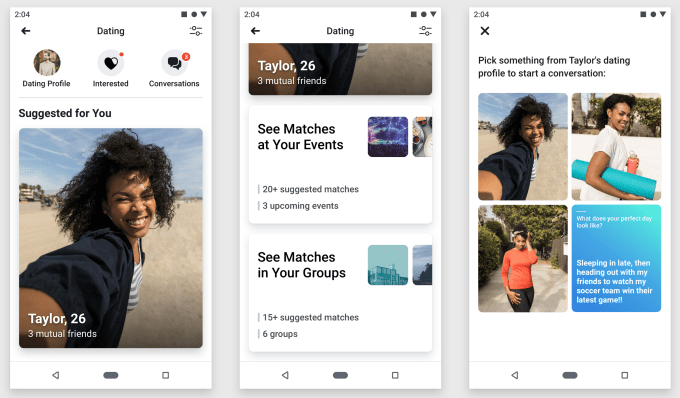
One concern with Secret Crush is that users might spam the feature by constantly adding a removing people from their list until they discover a match. That’s why Facebook will only let you sub out one person per day after you reach your initial limit of 9.
Currently there’s still no plan to monetize Dating, but that’s not the point. After years of scandals, Facebook needs to prove it deserves to be your social network. Mindlessly browsing the News Feed has proven to be exhausting and at times detrimental to health. But if the app can introduce you to your future spouse, or even just a summer fling, you might keep a place in your for Facebook too.
from RSSMix.com Mix ID 8176981 https://techcrunch.com/2019/04/30/facebook-dating-secret-crush/
http://www.gadgetscompared.com
from Tumblr https://ikonografico.tumblr.com/post/184557313431
via http://www.gadgetscompared.com
Instagram officially tests hiding Like counts
Would we feel less envious, shameful and competitive if Instagram didn’t tell us how many Likes a post received? That’s the idea behind Instagram now hiding Like counts from both a post’s viewers and its author as part of an experiment in Canada. A post’s creator can still open the Likers window to see the names of everyone who hearted their post, but they’d have to count them manually.
Even though Like totals would still impact how the algorithm ranks a post in the feed, if rolled out, the change would refocus Instagram on self-expression instead of being a popularity contest. Users might be less likely to delete a photo or video because it didn’t get enough Likes, or resort to their Finsta account to post something authentic but less “perfect.” It could make us less likely to envy-spiral because we wouldn’t see friends or influencers getting more Likes than us. And people might be more willing to post what truly represents their complicated identities because they’re not battling for the biggest Like count.

“Later this week, we’re running a test in Canada that removes the total number of likes on photos and video views in Feed, Permalink pages and Profile,” an Instagram spokesperson tells TechCrunch. “We are testing this because we want your followers to focus on the photos and videos you share, not how many likes they get.” The small percentage of Canadian users in the test will see a notice atop their feed warning them of “a change to how you see Likes.”
One big concern, though, is that influencers often get discovered for paid promotions or have their sponsored content measured by public Like counts or a screenshot of their Liker list. “We understand that this is important for many creators, and while this test is in exploratory stages, we are thinking through ways for them to communicate value to their brand partners,” an Instagram spokesperson tells TechCrunch.
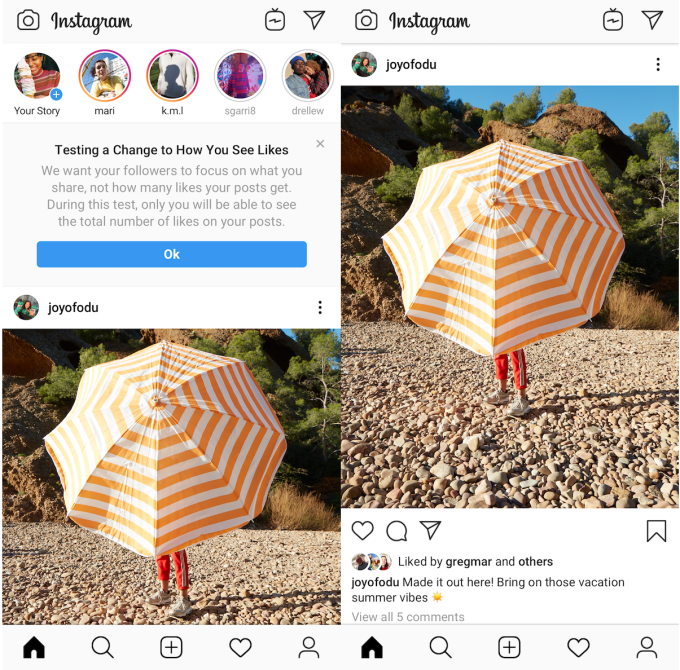
TechCrunch first reported two weeks ago that Instagram had prototyped hiding public Like counts, as spotted by Jane Manchun Wong. The company confirmed the feature had been built but not tested in the wild. The news immediately set off a wave of commentary from users. Many, while initially shocked, thought it would make Instagram usage healthier and cutback on some of the toxic anxiety produced by staring at the little numbers.
So why test in Canada? “Canadians are highly social and tech savvy, with over 24 million people connecting across our family of apps each month. We wanted to test this with a digitally savvy audience that has a thriving community on Instagram,” a company spokesperson told us.
It’s reassuring to see Instagram adding new well-being features after the departure of founders Kevin Systrom and Mike Krieger. Systrom in particular had been a big proponent of reducing envy and inauthenticity on social media, which was part of the impetus for launching Instagram Stories, where users could share unpolished looks at their lives. Before he left in September, Instagram rolled out its Your Activity dashboard showing the average time you spent per day on the app, plus a “You’re All Caught Up” warning that tells users they’ve seen all recent feed posts and can stop scrolling.
A 2013 study by Krasnova et al. discovered that 20 percent of envy-causing situations that experiment participants experienced happened on Facebook. They also determined that Facebook causes toxic envy, noting that “intensity of passive following is likely to reduce users’ life satisfaction in the long-run, as it triggers upward social comparison and invidious emotions.” Instagram, with its focus on imagery and manicured looks at our lives, might cause even more envy. Hiding Likes would be a strong step toward us judging ourselves less.
from RSSMix.com Mix ID 8176981 https://techcrunch.com/2019/04/30/instagram-hidden-like-counter/
http://www.gadgetscompared.com
from Tumblr https://ikonografico.tumblr.com/post/184557311931
via http://www.gadgetscompared.com
Facebook Messenger will get desktop apps, co-watching, emoji status
To win chat, Facebook Messenger must be as accessible as SMS, yet more entertaining than Snapchat. Today, Messenger pushes on both fronts with a series of announcements at Facebook’s F8 conference, including that it will launch Mac and PC desktop apps, a faster and smaller mobile app, simultaneous video co-watching and a revamped Friends tab, where friends can use an emoji to tell you what they’re up to or down for.
Facebook is also beefing up its tools for the 40 million active businesses and 300,000 businesses on Messenger, up from 200,000 businesses a year ago. Merchants will be able to let users book appointments at salons and masseuses, collect information with new lead generation chatbot templates and provide customer service to verified customers through authenticated m.me links. Facebook hopes this will boost the app beyond the 20 billion messages sent between people and businesses each month, which is up 10X from December 2017.
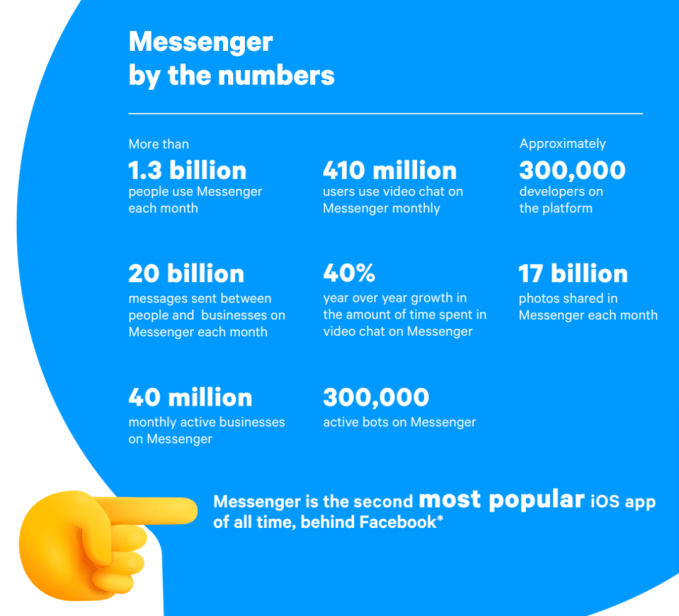
“We believe you can build practically any utility on top of messaging,” says Facebook’s head of Messenger Stan Chudnovsky. But he stresses that “All of the engineering behind it is has been redone” to make it more reliable, and to comply with CEO Mark Zuckerberg’s directive to unite the backends of Messenger, WhatsApp and Instagram Direct. “Of course, if we didn’t have to do all that, we’d be able to invest more in utilities. But we feel that utilities will be less functional if we don’t do that work. They need to go hand-in-hand together. Utilities will be more powerful, more functional and more desired if built on top of a system that’s interoperable and end-to-end encrypted.”
Here’s a look at the major Messenger announcements and why they’re important:
Messenger Desktop – A stripped-down version of Messenger focused on chat, audio and video calls will debut later this year. Chudnovsky says it will remove the need to juggle and resize browser tabs by giving you an always-accessible version of Messenger that can replace some of the unofficial knock-offs. Especially as Messenger focuses more on businesses, giving them a dedicated desktop interface could convince them to invest more in lead generation and customer service through Messenger.
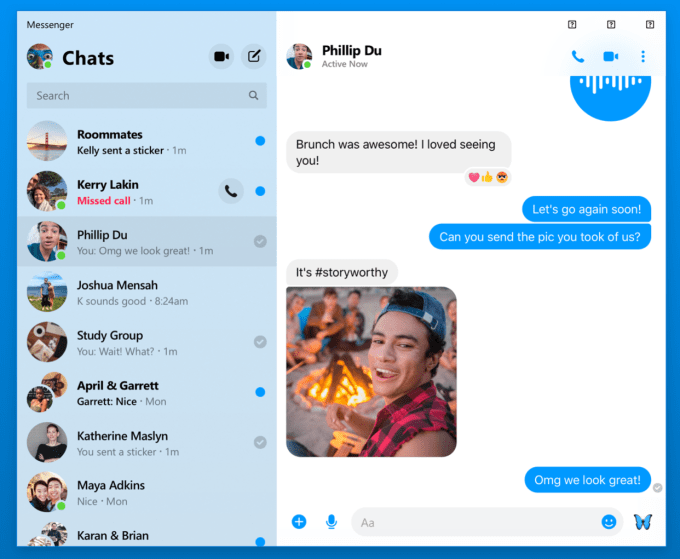
Facebook Messenger’s upcoming desktop app
Project Lightspeed – Messenger is reengineering its app to cut 70 mb off its download size so people with low-storage phones don’t have to delete as many photos to install it. In testing, the app can cold start in merely 1.3 seconds, which Chudnovsky says is just 25 percent of where Messenger and many other apps are today. While Facebook already offers Messenger Light for the developing world, making the main app faster for everyone else could help Messenger swoop in and steal users from the status quo of SMS. The Lightspeed update will roll out later this year.
Video Co-Watching – TechCrunch reported in November that Messenger was building a Facebook Watch Party-style experience that would let users pick videos to watch at the same time as a friend, with reaction cams of their faces shown below the video. Now in testing before rolling out later this year, users can pick any Facebook video, invite one or multiple friends and laugh together. Unique capabilities like this could make Messenger more entertaining between utilitarian chat threads and appeal to a younger audience Facebook is at risk of losing.
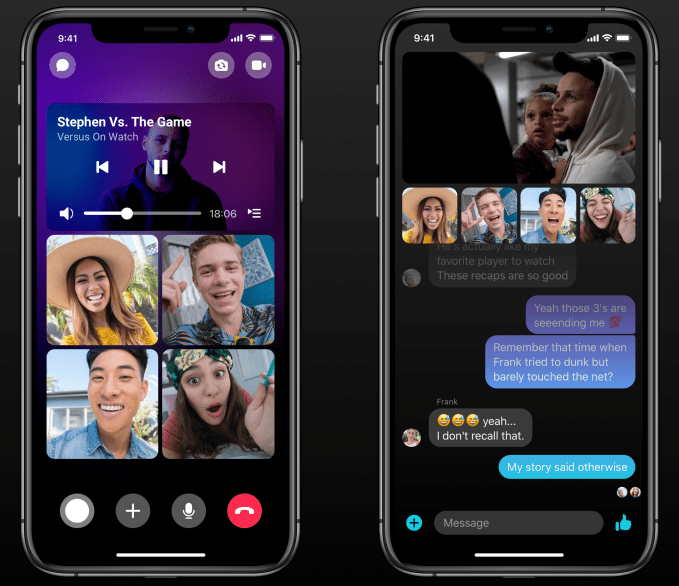
Watch Videos Together on Messenger
Business Tools – After a rough start to its chatbot program a few years ago, where bots couldn’t figure out users’ open-ended responses, Chudnovsky says the platform is now picking up steam with 300,000 developers on board. One option that’s worked especially well is lead-generation templates, which teach bots to ask people standardized questions to collect contact info or business intent, so Messenger is adding more of those templates with completion reminders and seamless hand-off to a live agent.
To let users interact with appointment-based businesses through a platform they’re already familiar with, Messenger launched a beta program for barbers, dentists and more that will soon open to let any business handle appointment booking through the app. And with new authenticated m.me links, a business can take a logged-in user on their website and pass them to Messenger while still knowing their order history and other info. Getting more businesses hooked on Messenger customer service could be very lucrative down the line.
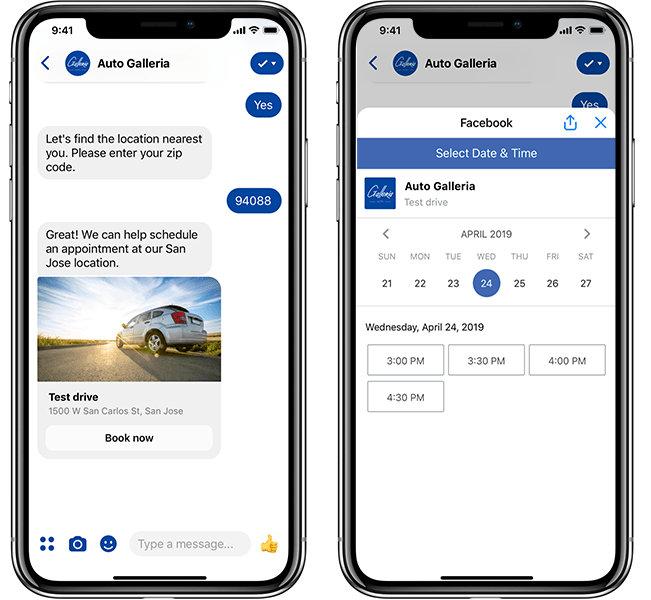
Appointment booking on Messenger
Close Friends and Emoji Status – Perhaps the most interesting update to Messenger, though, is its upcoming effort to help you make offline plans. Messenger is in the early stages of rebuilding its Friends tab into “Close Friends,” which will host big previews of friends’ Stories, photos shared in your chats, and let people overlay an emoji on their profile pic to show friends what they’re doing. We first reported this “Your Emoji” status update feature was being built a year ago, but it quietly cropped up in the video for Messenger Close Friends. This iteration lets you add an emoji like a home, barbell, low battery or beer mug, plus a short text description, to let friends know you’re back from work, at the gym, might not respond or are interested in getting a drink. These will show up atop the Close Friends tab as well as on location-sharing maps and more once this eventually rolls out.

Messenger’s upcoming Close Friends tab with Your Emoji status
Facebook Messenger is the best poised app to solve the loneliness problem. We often end up by ourselves because we’re not sure which of our friends are free to hang out, and we’re embarrassed to look desperate by constantly reaching out. But with emoji status, Messenger users could quietly signal their intentions without seeming needy. This “what are you doing offline” feature could be a whole social network of its own, as apps like Down To Lunch have tried. But with 1.3 billion users and built-in chat, Messenger has the ubiquity and utility to turn a hope into a hangout.
from RSSMix.com Mix ID 8176981 https://techcrunch.com/2019/04/30/facebook-messenger-desktop-app/
http://www.gadgetscompared.com
from Tumblr https://ikonografico.tumblr.com/post/184557311801
via http://www.gadgetscompared.com
Energizer’s massive battery/phone proves a viral hit ≠ crowdfunding success
Oof. This isn’t the sort of thing you want to see when you’re rounding the corner of your crowdfunding campaign:

There are long shots and then there’s coming up with $15,000 of your $1.2 million goal. The Indiegogo page for the Energizer Power Max P18K Pop understandably focused on the viral sensation the ridiculously beefy phone with the 18,000mAh battery spurred at Mobile World Congress this year. There are even photos of the scrum of journalists elbowing to take a shot of the thing at the event.
Understandable that its creators took that approach. Heck, the thing may have outshined all of the foldable and 5G phones that were set to take center stage at the event. We wrote about it. Lucas rightfully called it “basically a giant battery with a smartphone built into it.”
The takeaway seems clear, though. Just because everyone’s talking about a product doesn’t mean that anyone intends to buy it. If anything, the devices seemed more a comment on the state of smartphone battery life than actual enticing product.
And honestly, there’s been a shift in recent years among many smartphone manufacturers to provide power saving options and larger capacity batteries, so this has become less of a problem (though 5G’s approach could aversely impact that). Also, there are eight million power banks, and you can get them pretty cheap these days, making the P18K Pop any even sillier proposition. Not to mention all the things that can go wrong when you buy a phone based on a single feature.
Even so, the product’s creators closed the campaign out on a hopeful note, writing, “Although it didn’t reach its goal, we will work on further improvement on the P18K (design, thickness, etc.) as we do believe there is a rising interest for smartphones with incredible battery life, which can also be used as power banks.”
Certainly features from companies like Samsung and Huawei have proven that power sharing is a compelling feature. It just probably won’t come with Energizer’s name attached.
from RSSMix.com Mix ID 8176981 https://techcrunch.com/2019/04/30/energizers-massive-battery-phone-proves-a-viral-hit-%e2%89%a0-crowdfunding-success/
http://www.gadgetscompared.com
from Tumblr https://ikonografico.tumblr.com/post/184554961126
via http://www.gadgetscompared.com
Monday, April 29, 2019
Alphabet cites ‘headwinds’ in smartphone sales, teases I/O hardware announcement
Alphabet’s Q1 earnings were a disappointment for Wall Street, courtesy primarily of ad revenue shortcomings. The hardware team met with some difficulties, as well, owing in part to a stagnating global smartphone market that has impacted virtually all players.
CEO Sundar Pichai cited “year over year headwinds” when referring to the company’s smartphone line, following the release of the Pixel 3 and Pixel 3 XL last fall. The executive rightly referenced the company’s relatively recent entry as a standalone hardware developer and painted a hopeful picture of the industry’s innovations going forward.
“I do continue to be excited to see 5G coming and the early foldable phones, which Android plays a big part in driving,” Pichai said on the call. Google has notably taken an important role developing an Android UI designed for the foldable form factor, along with working closely beside Samsung on its recently delayed foldable.
CFO Ruth Porat echoed Pichai’s comments, while hinting at what’s to come from the company. “While the first quarter results reflect pressure in the premium smartphone industry,” the exec explained, “we are pleased with the ongoing momentum of Assistant-enabled Home devices, particularly the Home Hub and Mini devices and look forward to our May 7 announcement at I/O from our hardware team.”
The reference to “premium smartphone[s]” looks to be a roundabout confirmation of the rumored Pixel 3a. The mid-tier take on the Pixel line is rumored to be a rare I/O hardware debut, coming next month. The arrival of such a device could go a ways toward helping jumpstart slowing sales for the line.
Pichai referenced the company’s newly opened “campus and engineering hub.” A result of the company’s massive deal with struggling handset maker, HTC, the Taipei R&D center will be primarily focused on Google’s smartphone offerings. He also referenced the company’s Amazon-competing Home line as a bright spot for its hardware offerings, particularly the Mini and Hub.
“If you take products like Google Home and Assistant products, we’ve been doing really well,” said Pichai. “We see strong momentum. We’re market leaders in the category, especially when you look at it on a global basis.”
from RSSMix.com Mix ID 8176981 https://techcrunch.com/2019/04/29/alphabet-cites-headwinds-in-smartphone-sales-teases-i-o-hardware-announcement/
http://www.gadgetscompared.com
from Tumblr https://ikonografico.tumblr.com/post/184541308826
via http://www.gadgetscompared.com
Friday, April 26, 2019
Twitter makes ‘likes’ easier to use in its twttr prototype app. (Nobody tell Jack.)
On the one hand, you’ve got Twitter CEO Jack Dorsey lamenting the “like” button’s existence, and threatening to just kill the thing off entirely for incentivizing the wrong kind of behavior. On the other hand, you have twttr — Twitter’s prototype app where the company is testing new concepts including, most recently, a way to make liking tweets even easier than before.
Confused about Twitter’s product direction? Apparently, so is the company.
In the latest version of the twttr prototype, released on Thursday, users are now able to swipe right to left on any tweet in order to “like” it. Previously, this gesture only worked on tweets in conversation threads, where the engagement buttons had been hidden. With the change, however, the swipe works anywhere — including the Home timeline, the Notifications tab, your Profile page, or even within Twitter Search results. In other words, it becomes a more universal gesture.
You like their Tweets. Swipe right and really show them. No seriously, you can now swipe right on any Tweet on twttr to like it on your Home timeline, notifications tab, profile page, or search results.
— Twitter Support (@TwitterSupport) April 25, 2019
This makes sense because once you got used to swiping right, it was confusing that the gesture didn’t work in some places, but did in others. Still, it’s odd to see the company doubling down on making “likes” easier to use — and even rolling out a feature that could increase user engagement with the “Like” button — given Jack Dorsey’s repeated comments about his distaste for “likes” and the conversations around the button’s removal.
Of course, twttr is not supposed to be Dorsey’s vision. Instead, it’s meant to be a new experiment in product development, where users and Twitter’s product teams work together, in the open, to develop, test, and then one day officially launch new features for Twitter.
For the time being, the app is largely focused on redesigning conversation threads. On Twitter today, these get long and unwieldy, and it’s not always clear who’s talking to who. On twttr, however, threads are nested with a thin line connecting the various posts.
The app is also rolling out other, smaller tweaks like labels on tweets within conversations that highlight the original “Author’s” replies, or if a post comes from someone you’re “following.”
And, of course, twttr introduced the “swipe to like” gesture.
While it’s one thing to want to collaborate more directly with the community, it seems strange that twttr is rolling out a feature designed to increase — not decrease — engagement with “likes” at this point in time.
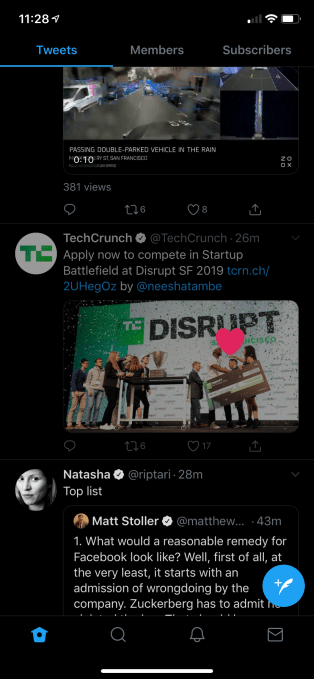
Last August, for example, Dorsey said he wanted to redesign key elements of the social network, including the “like” button and the way Twitter displays follower counts.
“The most important thing that we can do is we look at the incentives that we’re building into our product,” Dorsey had said at the time. “Because they do express a point of view of what we want people to do — and I don’t think they are correct anymore.”
Soon after, at an industry event in October 2018, Dorsey again noted how the “like” button sends the wrong kind of message.
“Right now we have a big ‘like’ button with a heart on it, and we’re incentivizing people to want to drive that up,” said Dorsey. “We have a follower count that was bolded because it felt good twelve years ago, but that’s what people see us saying: that should go up. Is that the right thing?,” he wondered.
Short story on “like.” We’ve been open that we’re considering it. Jack even mentioned it in front of the US Congress. There’s no timeline. It’s not happening “soon.” https://t.co/jXBmkudWYv
— Brandon Borrman (@bborrman) October 29, 2018
While these comments may have seemed like a little navel-gazing over Twitter’s past, a Telegraph report about the “like” button’s removal quickly caught fire. It claimed Dorsey had said the “like” button was going to go away entirely, which caused so much user backlash that Twitter comms had to respond. The company said the idea has been discussed, but it wasn’t something happening “soon.” (See above tweet).
Arguably, the “like” button is appreciated by Twitter’s user base, so it’s not surprising that a gesture that could increase its usage would become something that gets tried out in the community-led twttr prototype app. It’s worth noting, however, how remarkably different the development process is when it’s about what Twitter’s users want, not the CEO.
Hmmm.
Hey, twttr team? Maybe we can get that “edit” button now?
from RSSMix.com Mix ID 8176981 https://techcrunch.com/2019/04/26/twitter-makes-likes-easier-to-use-in-its-twttr-prototype-app-nobody-tell-jack/
http://www.gadgetscompared.com
from Tumblr https://ikonografico.tumblr.com/post/184463875516
via http://www.gadgetscompared.com
RosieReality, a Swiss startup using AR to get kids interested in robotics and programming, scores £2.2M seed
RosieReality, a startup out of Zürich developing consumer augmented reality experiences, has raised $2.2 million in seed funding led by RedAlpine. Other backers include Shasta Ventures, Atomico Partners Mattias Ljungman and Siraj Khaliq (both of whom invested in a personal capacity), and Akatsuki Entertainment Fund.
Founded in early 2018, RosieReality’s first AR experience is designed to ignite kids interested in robotics and programming. The smart phone camera-based app is centred around “Rosie,” a cute AR robot that inhabits a “Lego-like” modular AR world within which you and your friends are tasked with building and solving world-size 3D puzzles.
The kicker: to solve these 3D-puzzle games requires “programming” Rosie to move around the augmented reality world.
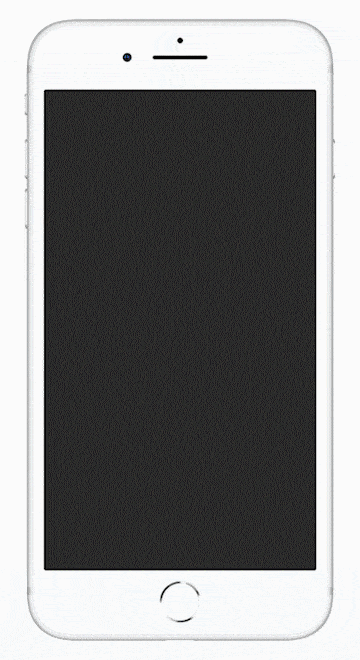 “By developing Rosie the Robot, we created the first interactive and modular world that exclusively lives in your camera feed,” RosieReality co-founder and CEO Selim Benayat tells TechCrunch. “We use this new computational platform to enable kids to creatively build, solve and share world-sized puzzle games with friends and families – much like modern-day Lego”.
“By developing Rosie the Robot, we created the first interactive and modular world that exclusively lives in your camera feed,” RosieReality co-founder and CEO Selim Benayat tells TechCrunch. “We use this new computational platform to enable kids to creatively build, solve and share world-sized puzzle games with friends and families – much like modern-day Lego”.
Describing Rosie the Robot’s typical users as teens that “like the challenge of intricately crafted puzzles,” Benayat says part of the inspiration behind the AR game was remembering how as a kid he used to love spending time building stuff and then inviting friends over to show them what he’d built.
“Kids today are not that different,” he argues, before adding that AR makes it possible for them to have the same tangible and contextual sensation while giving them a bigger outlet for their creativity.
“We see the camera as a tool to teach and enable [the] next generation of creators. For us gaming is the ultimate creative, social and educational outlet,” says the RosieReality CEO.
from RSSMix.com Mix ID 8176981 https://techcrunch.com/2019/04/26/rosiereality/
http://www.gadgetscompared.com
from Tumblr https://ikonografico.tumblr.com/post/184457619921
via http://www.gadgetscompared.com
Thursday, April 25, 2019
Snapchat will let you play as your Bitmoji in video games
Want your video game character to look just like you? Soon you’ll be able to scan an in-game code with Snapchat to play as your personalized Bitmoji avatar on PC, console, and mobile games. Today Snapchat announced is new Bitmoji For Games SDK that will let hand-selected partners integrate 3D Bitmoji as a replacement for their character skins. With support for Unity, Unreal, and the Play Canvas engine behind Snap’s new Bitmoji Party game inside Snapchat, the SDK should make it easy for developers to pipe in life-like avatars that give people a stronger emotional connection to the game.
“It’s kind of a no-brainer to bring Bitmoji into games. Games can be so much more engaging with you…in the game” Bitmoji co-founder Ba Blackstock tells me. “We’re adding an identity layer to gaming that has the potential to have a transformational effect on the industry.”
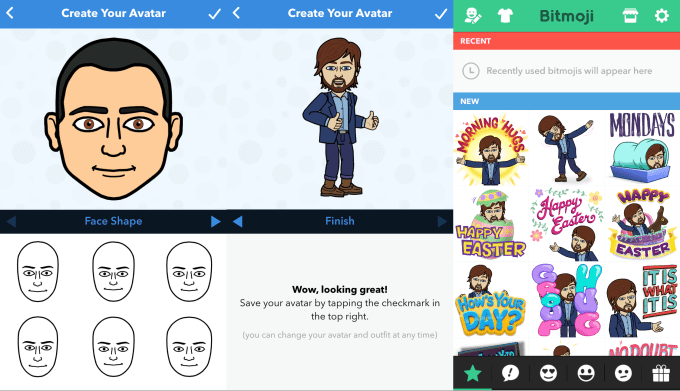
Snapchat has a massive opportunity to colonize the web — and the games ecosystem — with its Bitmoji instead of waiting for developers to make half-assed clones. Bitmoji is perhaps Snapchat’s most popular and enduring feature now that Stories and ephemeral messaging have been widely copied, with 330 million estimated downloads according to Sensor Tower. As I wrote in my feature piece on Snapchat’s new platform strategy, “To stop copycats, Snapchat shares itself”, every distributed instance of the company drives attention back to its original apps, and each partnership it establishes is one more ally in the fight against Facebook.
Snap’s New CMO

Snap’s new CMO Kenny Mitchell
As Snapchat moves into this new era of marketing itself through Bitmoji, today it also announced it’s hired a new CMO, Kenny Mitchell. He was formerly the VP of marketing at McDonald’s and the head of consumer engagement at Gatorade. Mitchell oversaw the sports drink’s Serena Wlliams tennis game that lived inside a Snapchat ad and saw an average of over 200 seconds of play time, and its viral Super Bowl augmented reality lens that let you dump a cooler of Gatorade on yourself.
“Kenny’s consumer marketing expertise and his deep understanding of our products will be a great combination for Snap” writes Snap CEO Evan Spiegel.
The company has seen many senior execs depart over the years due to clashes with Spiegel over leadership, so we’ll see if Mitchel sticks around. He’ll be spearheading Snap’s new marketing campaign to reactivate Android users frustrated by its buggy app and bring them back to its newly reengineered version. “I look forward to helping Evan and Snap continue to tell their story to people around the world, and working with my new colleagues as we define the future of the camera and self-expression” Mitchell writes.
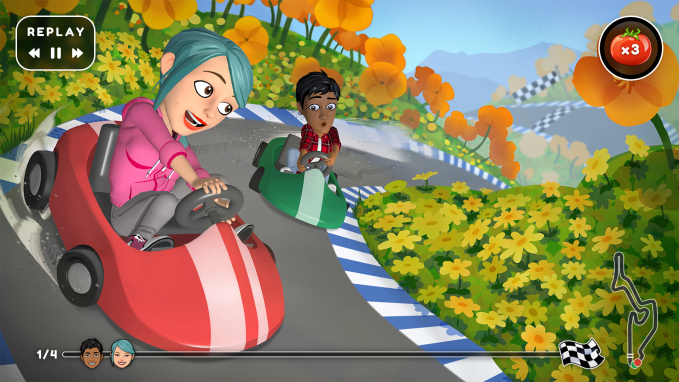
Bitmoji, The Visual Identity Layer
Snap acquired Bitmoji parent Bitstrips in 2016 for just $64 million, propelling it to become a staple top 10 app. Snap launched its Snap Kit platform in June 2018, allowing developers to integrate Bitmoji into the keyboards of their apps like Tinder for use as chat stickers or 2D profile pics. And this month at Snap’s first Partner Summit, it launched partnerships to bring Bitmoji to the Venmo feed, Fitbit watch faces, and more. But now it will let 3D Bitmoji replace your in-game character head-to-toe.
For now, the SDK will be free to top developers chosen for the program from PC, Mac, Xbox, Playstation, Nintendo Switch, iOS, Android and other platforms. Surprisingly, most game devs just build their own avatar customization feature from scratch, but they’re typically focused on clothes and crazy hairstyles than fine-tuning a face that looks like your own. And while customized avatars are common in shooter games, Bitmoji could bring them to platform, racing, dancing, puzzle, fighting, and role-playing games too.
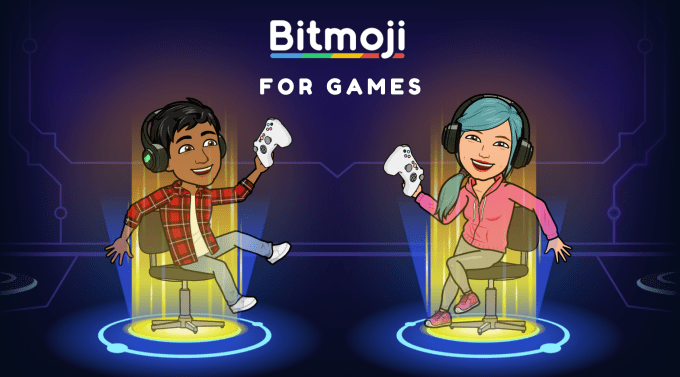
Bitmoji For games won’t be an open platform to ensure the brand isn’t misused. Blackstock explains that “You can look at what we’re doing with Bitmoji Kit where we have guidelines of best practices of how to use Bitmoji and not use Bitmoji. We’ll apply the same kinds of guidelines to gaming.” That might mean no extra graphically violent games, or anything in which players might revel in inflicting pain on a personalized avatar. But Fortnite, with its cartoony violence might be an ideal Bitmoji partner.
Snap’s global head of gaming partnerships John Imah says he could imagine using his Bitmoji in titles from Star Wars, Lego, Mario Kart, or Warcraft. Depending on how their models for characters, landscapes, and items work, developers may have to do some work to make BItmoji work gracefully. But Imah says when it can “There will be some modification on our end to make sure this works within their engine so we can make this process as seamless as possible for these developers.”
Users will design their avatar in the Bitmoji or Snapchat app, though there may be in-game customization options down the line. If users ask to import their Bitmoji, the game will show a QR Snapcode on screen that users can scan with the Snapchat camera. That authentication unlocks their Bitmoji to use as an avatar skin in the game. Suddenly, every quest, battle, and cutscene becomes about them, not some generic character.

Given Fortnite is earning hundreds of millions of dollars selling cosmetic upgrades, the inevitable question is whether Snap will start selling bonus outfits, items, or face options for Bitmoji. “It’s really early days for Bitmoji For Games. It’s something we’ll explore later down the road” Imah tells me. Imagine if kids could buy Supreme sweatshirts or fresh Nikes for their Bitmoji? That could be a lucrative new business for Snap that’s strengthened by each Bitmoji partnership, and at a time when it’s eager to boost revenue and cut losses as it aims for profitability.
Bitmoji For Games could cement Snapchat as the best way to visually represent yourself online without a photograph. As the darker sides of the Internet and human nature come into focus for the tech industry, we need more ways to both be ourselves while retaining privacy. Bitmoji could deliver the emotional connection of seeing yourself as the hero without the risks of exposing your true face.
from RSSMix.com Mix ID 8176981 https://techcrunch.com/2019/04/25/snapchat-bitmoji-for-games-sdk/
http://www.gadgetscompared.com
from Tumblr https://ikonografico.tumblr.com/post/184438396691
via http://www.gadgetscompared.com
Wednesday, April 24, 2019
You might hate it, but Facebook Stories now has 500M users
You might think it’s redundant with Instagram Stories, or just don’t want to see high school friends’ boring lives, but ephemeral Snapchat-style Stories now have 500 million daily users across Facebook and Messenger. WhatsApp’s Stories feature Status has 500 million dailies too, and Instagram hit that milestone three months ago. That’s impressive, because it means one-third of Facebook’s 1.56 billion daily users are posting or watching Stories each day, up from zero when Facebook launched the feature two years ago.
For reference, Stories inventor Snapchat has just 190 million total daily users.
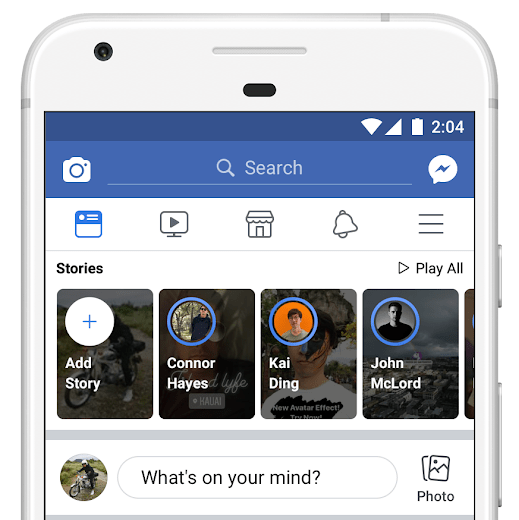
Facebook Stories
CEO Mark Zuckerberg announced the new stats on today’s Facebook Q1 2019 earnings call, which showed it’s user growth rate had increased but it had to save $3 billion for a potential FTC fine over privacy practices.
Facebook isn’t just using Stories to keep people engaged, but to squeeze more cash out of them. Today COO Sheryl Sandberg announced that 3 million advertisers have now bought Stories ads across Facebook’s family of apps. I’d expect Facebook to launch a Stories Ad Network soon so other apps can show Facebook’s vertical video ads and get a cut of the revenue.
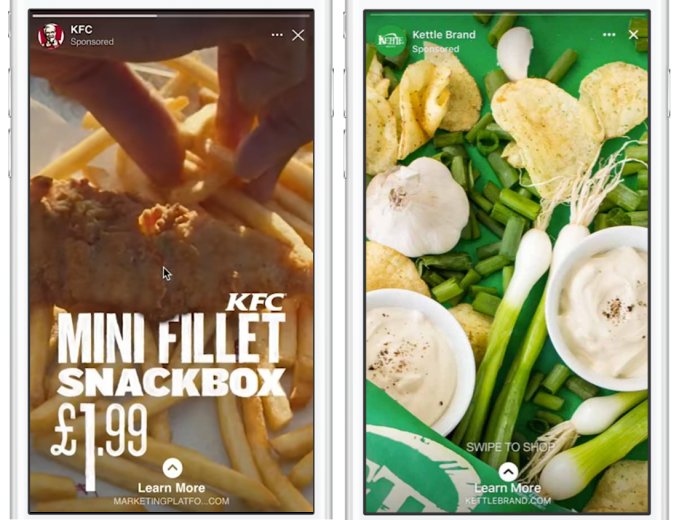
Facebook’s aggressive move to clone Snapchat Stories not just in Instagram but everywhere might have pissed users off at first, but many of them have come around. If you give people a place to put their face at the top of their friends’ phones, they’ll fill it. And if someone dangles a window into the lives of people you know and people you wish you did, you’ll open that window regularly.
from RSSMix.com Mix ID 8176981 https://techcrunch.com/2019/04/24/facebook-stories-500-million/
http://www.gadgetscompared.com
from Tumblr https://ikonografico.tumblr.com/post/184423790736
via http://www.gadgetscompared.com
Samsung Galaxy Fold review: future shock
The Galaxy Fold has been the most polarizing product I can recall having reviewed. Everyone who saw it wanted to play with the long-promised smartphone paradigm shift. The results, on the other hand, were far more mixed.
If nothing else, the Fold has a remarkably high Q-Rating. Each person who saw me using the product had at least a vague idea of what it was all about. I honestly can’t remember the last time I’ve had that reaction with a non-iPhone device. That’s great from brand perspective. It means a lot of people are curious and potentially open to the notion that the Samsung Galaxy Fold is the future.
Of course, it also means there are a lot of people looking on if you fail.
In some ways, this past week with the Samsung Galaxy Fold has been an extremely public beta. A handful of samples were given out to reviewers. Most worked fine (mine included), but at least three failed. It’s what we in the industry call a “PR nightmare.” Or at least it would be for most companies.
Samsung’s weathered larger storms — most notably with the Galaxy Note 7 a few years back. Of course, that device made it much further along, ultimately resulting in two large-scale recalls. The nature of the two issues was also vastly different. A malfunctioning screen doesn’t put the user at bodily risk like an exploding battery. The optics on these things don’t get much worse than having your smartphone banned from planes.
As of this writing, the Fold is still set to go on sale, most likely this year. To be perfectly frank, the April 26 release date seemed overly optimistic well before the first reports of malfunctioning units. It’s never a great sign when a device is announced in February and is only made available for review a few weeks ahead of launch. It’s kind of like when a studio doesn’t let reviewers watch a film before release. It doesn’t necessarily mean it’s bad, but it’s something to keep an eye on.
That’s the thing. The Galaxy Fold is the kind of device you want badly to succeed. You want it to be great and you want Samsung to sell a billion because it’s a genuinely exciting product after a decade of phones that look mostly the same. There’s also the fact that Samsung has essentially been hyping this thing for eight years, since it debuted a flexible display at CES 2011.
In spite of that, however, the home stretch feels rushed. Samsung no doubt saw the writing on the wall, as companies like Huawei readied their own foldable. And while Royole beat the fold to market, Samsung still had a very good shot at the claim of first commercially viable foldable on the market, with a decade of Galaxy devices under its belt and hand-in-hand work with the Google team to create an Android UX that makes sense on a pair of very different screens.
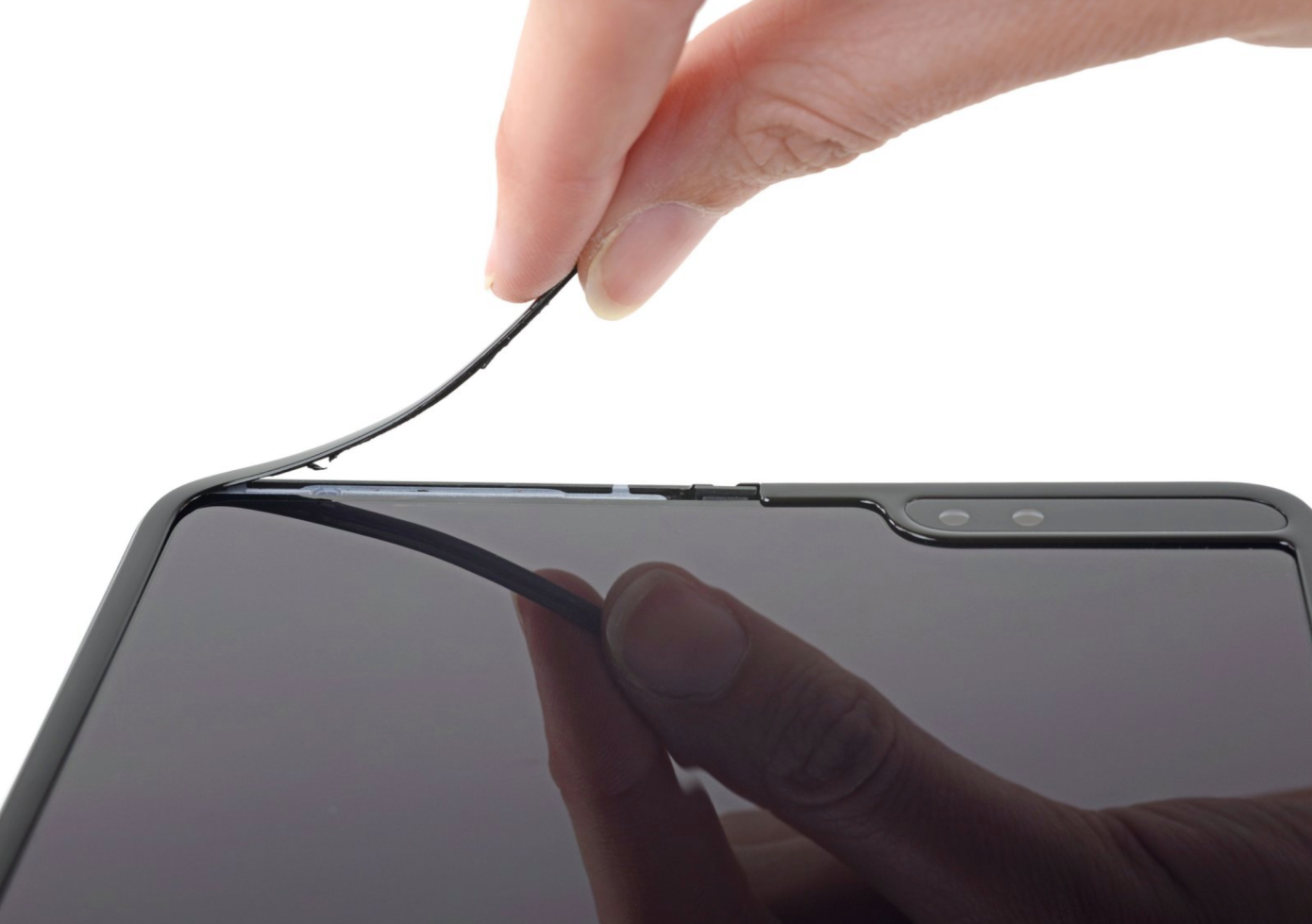
[Source: iFixit]
But this iFixit teardown speaks volumes. “Alarmingly” isn’t the kind of word you want/expect to hear about a company like Samsung, but there it is, followed directly by “fragile” — itself repeated five times over the course of the write-up. iFixit’s findings match up pretty closely with Samsung’s own reports:
- A fragile display means knocking it the wrong way can result in disaster.
- A gap in the hinges allows dirt and other particles to wedge themselves between the folding mechanism and screen.
- Don’t peel off the protective layer. I know it looks like you should, but this is probably the easiest way to wreck your $2,000 phone that doesn’t involve a firearm or blender.
What makes all of this doubly unfortunate is that Samsung has about as much experience as anyone making a rugged phone that works. I feel confident that the company will do just that in future generations, but unless the company can come back with definitive evidence that it’s overhauled the product ahead of launch, this is a difficult product to recommend.
Samsung knew the first-gen Galaxy Fold would be a hard sell, of course. The company was pretty transparent about the fact that the experimental form factor, coupled with the $1,980 price tag, meant the device will only appeal to a small segment of early adopters.
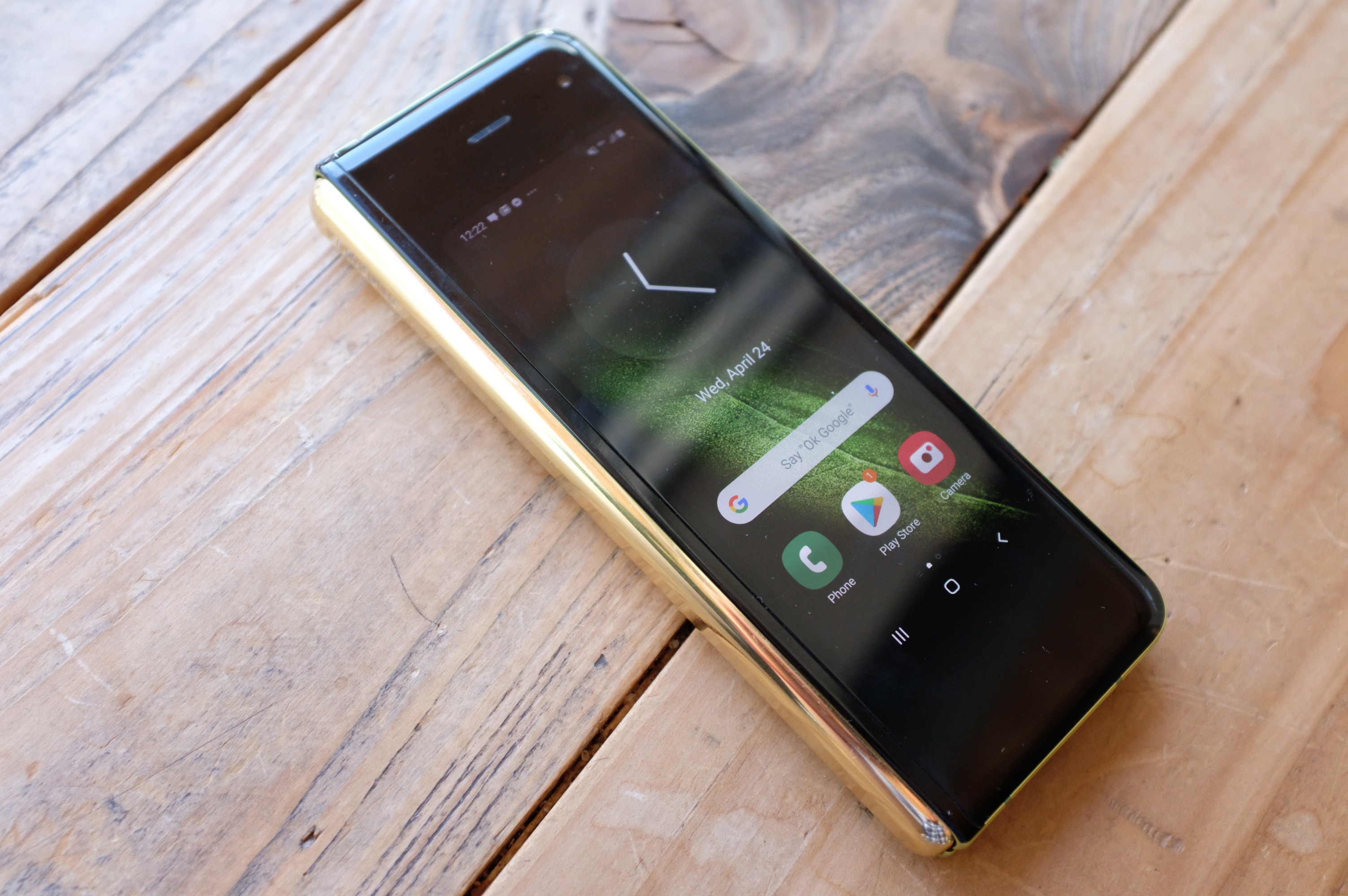
Even so, the company managed to sell out of preorders — though it didn’t say how large that initial run was. Nor are we sure how many users have canceled in the wake of this past week’s events. Certainly no one would blame them for doing so at this point.
But while the apocalyptic shit-posters among us will declare the death of the foldable before it was ever truly born, whatever doesn’t kill Samsung has only made it stronger. And this misfire could ultimately do that for both the company and the category, courtesy of its informal beta testing.
Rewind a mere week or so ago (seriously, it’s only been that long), when we finally got our hands on the Galaxy Fold. I was impressed. And I certainly wasn’t alone. Admittedly, there’s a bit of a glow that first time you see a device that’s seemingly been teased forever. The fact that it exists feels like a kind of victory in and of itself. But the Fold does an admirable job marrying Samsung’s hardware expertise with a new form factor. And more importantly, it’s real and works as advertised — well, mostly, at least.
The truth is, I’ve mostly enjoyed my time with the Galaxy Fold. And indeed, it’s been fun chronicling it on a (nearly) daily basis. There are some things the form factor is great for — like looking at Google Maps or propping it up to watch YouTube videos on the elliptical machine at the gym. There are others when the bulky form factor left me wanting to go back to my regular old smartphone — but those trade-offs are to be expected.
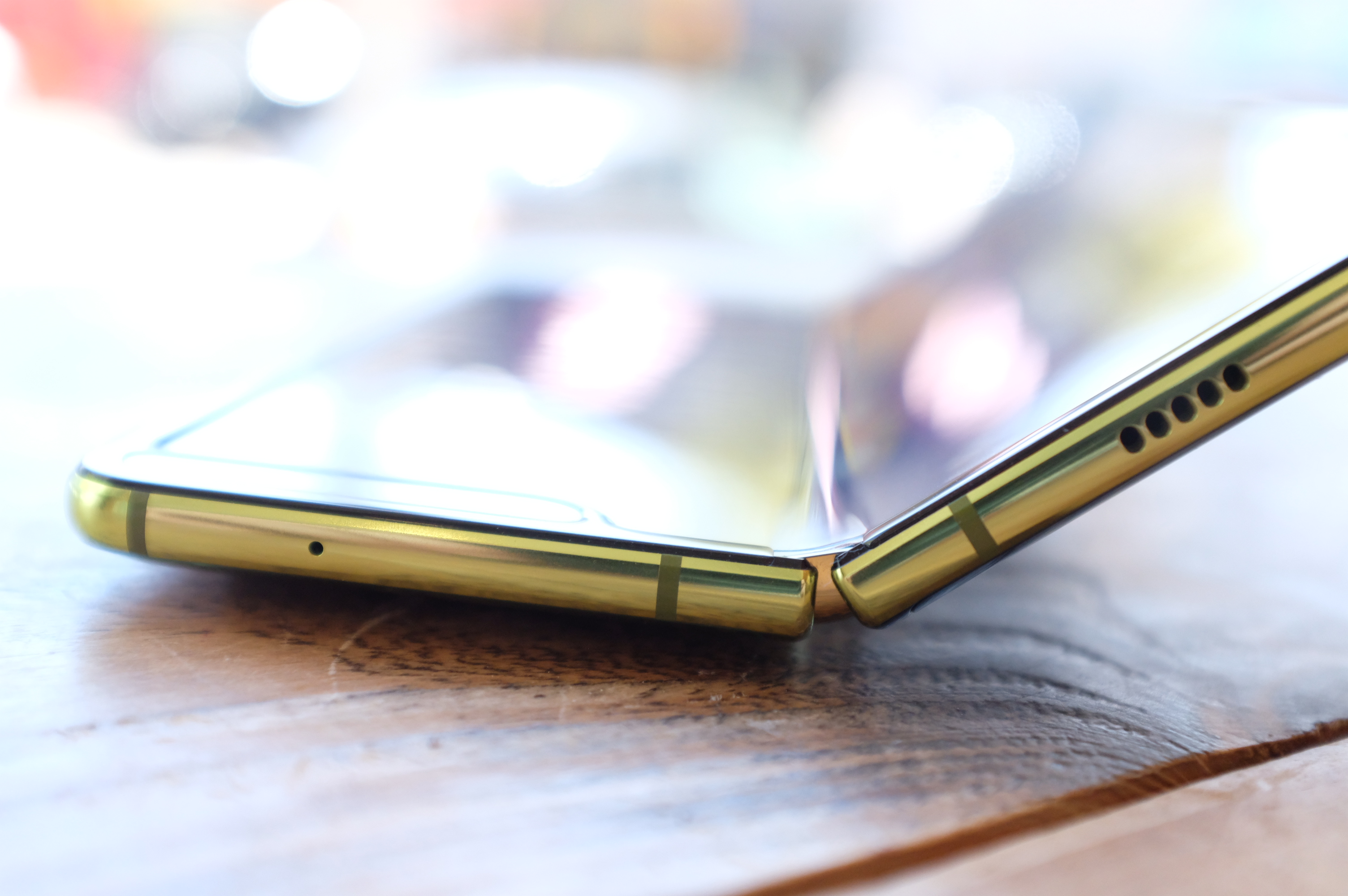
I both like the Fold’s design and understand the criticism. Samsung’s done a good job maintaining the Galaxy line’s iconic design language. The foldable looks right at home alongside the S and Note. That said, the rounded backing adds some bulk to the product. And while open, the device is thinner than an iPhone, when folded, it’s more than double the thickness, owing to a gap between the displays. It’s quite skinny in this mode, however, so it should slip nicely into all but the tightest pants pockets.
In practice, the folding mechanism might be the most impressive part of the product. The inside features several interlocking gears that allow the product to open and shut with ease and let users interact with the device at various states of unfold. I found myself using the device with it open at a 90-degree angle quite a bit, resting in my hand like an open book. The Fold features a pair of magnets on its edges, which let you close it with a satisfying snap. It’s weirdly therapeutic.
Really, the biggest strike against the device from a purely aesthetic standpoint is that it’s not the Mate X. Announced by Huawei a few days after the Fold’s big unveil, the device takes a decidedly more minimalist approach to the category. It’s an elegant design that features less device and more screen, and, honestly, the kind of thing I don’t think most of us expected until at least the second-generation product.
The gulf between the two devices is especially apparent when it comes to the front screen. The front of the screen is around two-fifths bezel, leaving room for a 4.6-inch display with an awkward aspect ratio. The Mate X, meanwhile, features a 6.6-inch front-facing AND 6.4-inch rear-facing display (not to mention the larger eight-inch internal display to the Fold’s 7.3).
There’s reason to recommend the Fold over the Mate X, as well. I can’t speak to the difference in user experience, having only briefly interacted with the Huawei, but the price point is a biggie. The Mate X starts at an even more absurd $2,600, thanks in part to the fact that it will only be available in a 5G version, adding another layer of niche.
That price, mind you, is converted from euros, because 1) The product was announced at MWC in Barcelona and 2) U.S. availability is likely to be a nonstarter again, as the company continues to struggle with U.S. regulators.
Of course, the Fold’s U.S. availability is also in limbo at the moment, albeit for very different reasons.
I ultimately spent little time interacting with the front screen. It’s good for checking notifications and the like, but attempting to type on that skinny screen is close to impossible, with shades of the new Palm device, which implements its own shortcuts to get around those shortcomings. The inside, meanwhile, takes a butterfly keyboard approach, so you can type with both thumbs while holding it open like a book.
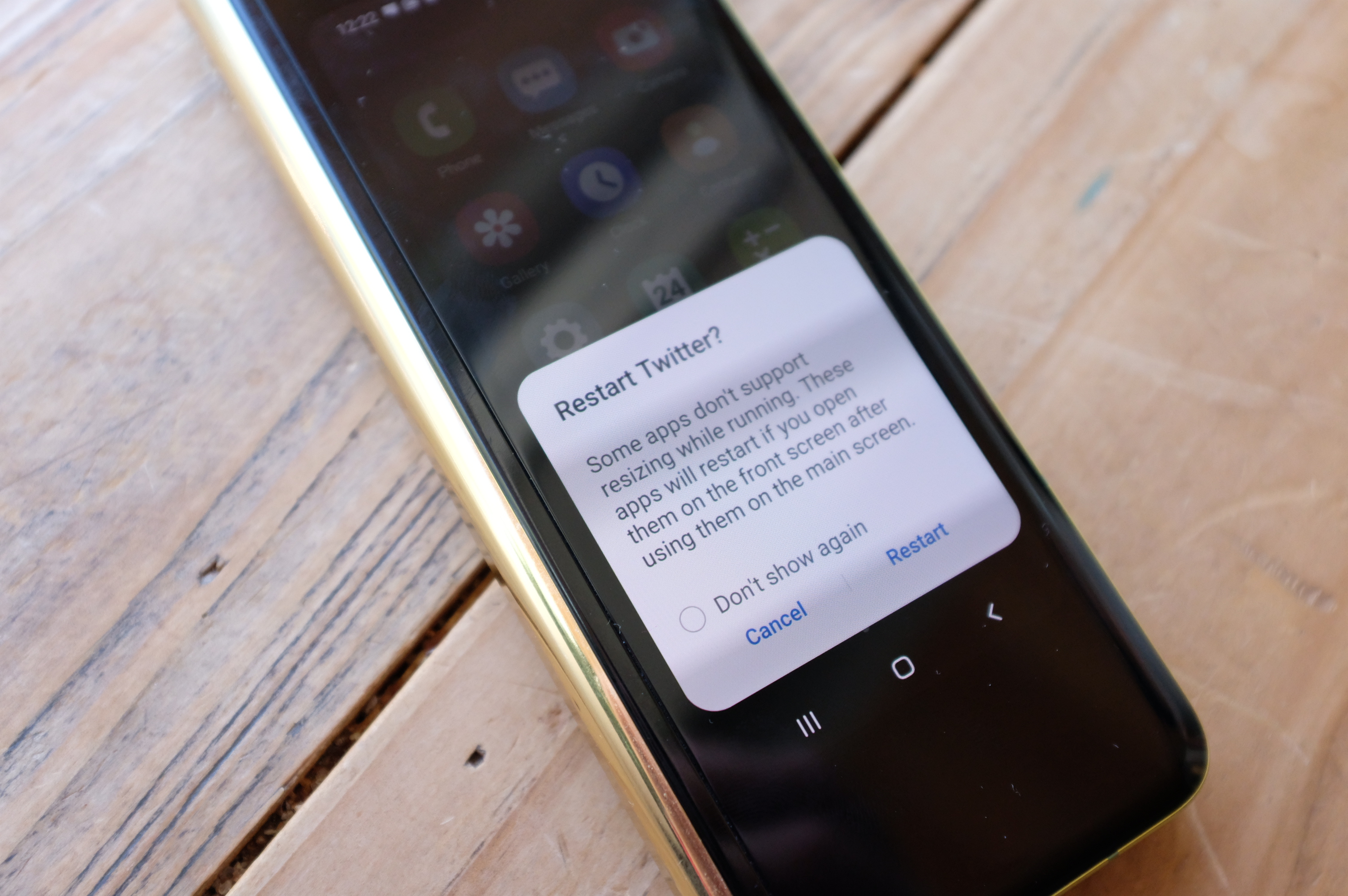
There’s also the issue of app optimization. A lot of this can be chalked up to an early version of a first-gen device. But as with every new device, the equation of how much developer time to invest is largely dependent on product adoption. If the Fold and future Fold’s aren’t a success, developers are going to be far less inclined to invest the hours.
This is most painfully obvious when it comes to App Continuity, one of the device’s primary selling points from a software perspective. When working as advertised, it makes a compelling case for the dual screens. Open something on the front and expand your canvas by unfolding the device. Google is among the companies that worked directly with Samsung to optimize apps this way, and it’s particularly handy with Maps. I used it a fair amount on my trip last week to Berkeley (shout out to the fine people at Pegasus Books on Shattuck).
When an app isn’t optimized, Samsung compels you to restart it, or else you get a nasty case of letterbox bars that retain the aspect ratio of the front screen. Continuity isn’t designed to work the other way, either — opening something on the large screen and then transferring to the front. That’s a bit trickier, as shutting the phone is designed to offer a kind of finality to that session, like hitting the power button to put the device to sleep.
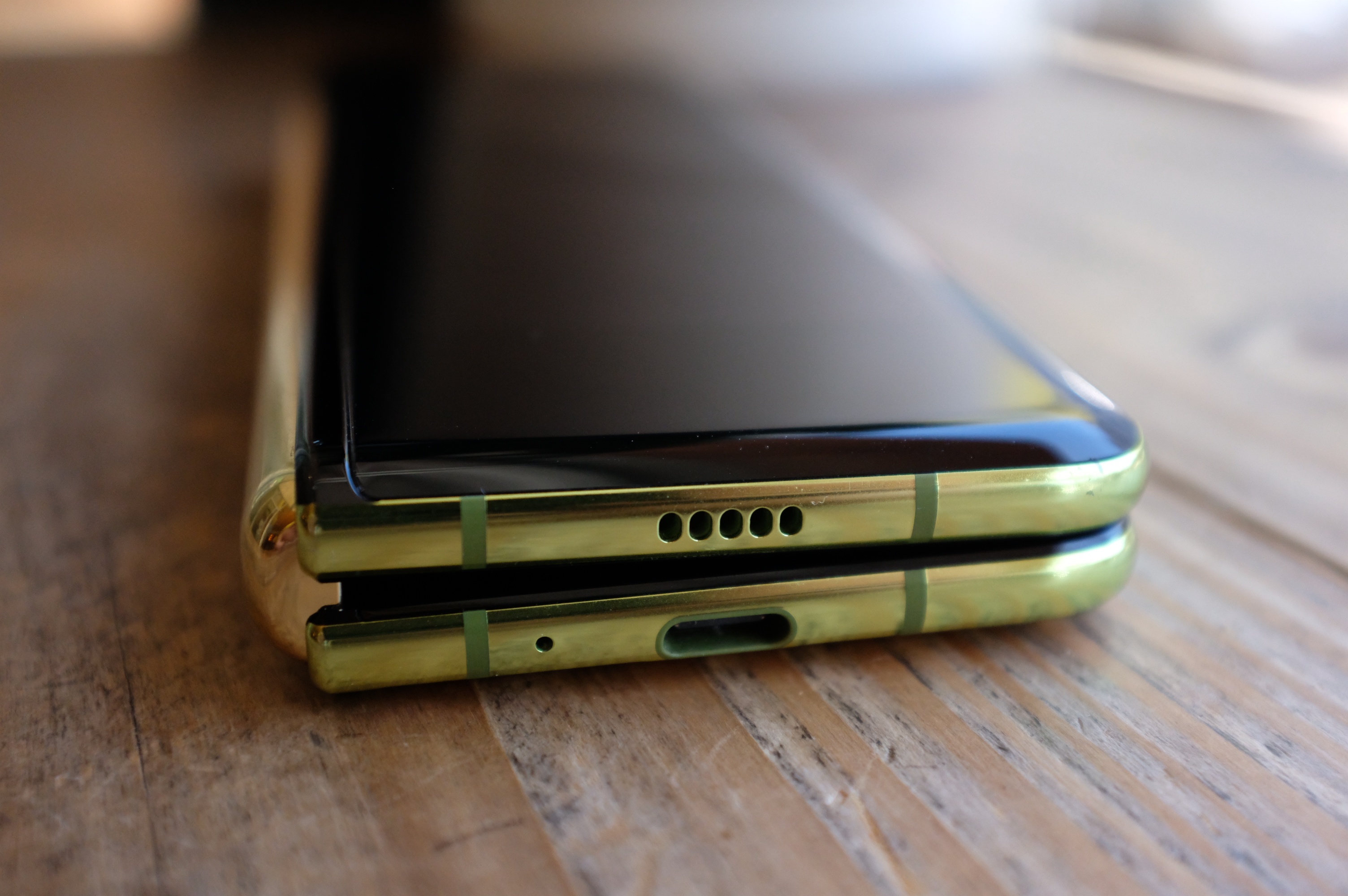
I get that, and like many other pieces here, it will be interesting to see how people utilize it. Aside from the obvious hardware concerns, much of the work on the second-generation device will center around learnings from how users interact with this model. I know I surprised myself when I ended up using the 7.3-inch screen to snap photos. It felt silly — like those people who bring iPads to photograph events. But it’s ultimately a much better viewfinder than that measly 4.6-incher.
That’s really just the tip of the iceberg for the inside screen, of course. The size, which is somewhere between phablet and mini tablet, provides ample real estate that can still be held in one hand. It’s a great size for short videos. I’ve watched a lot of YouTube on this thing, though the speakers (a small series of holes on the upper and lower edges) leave a lot to be desired.
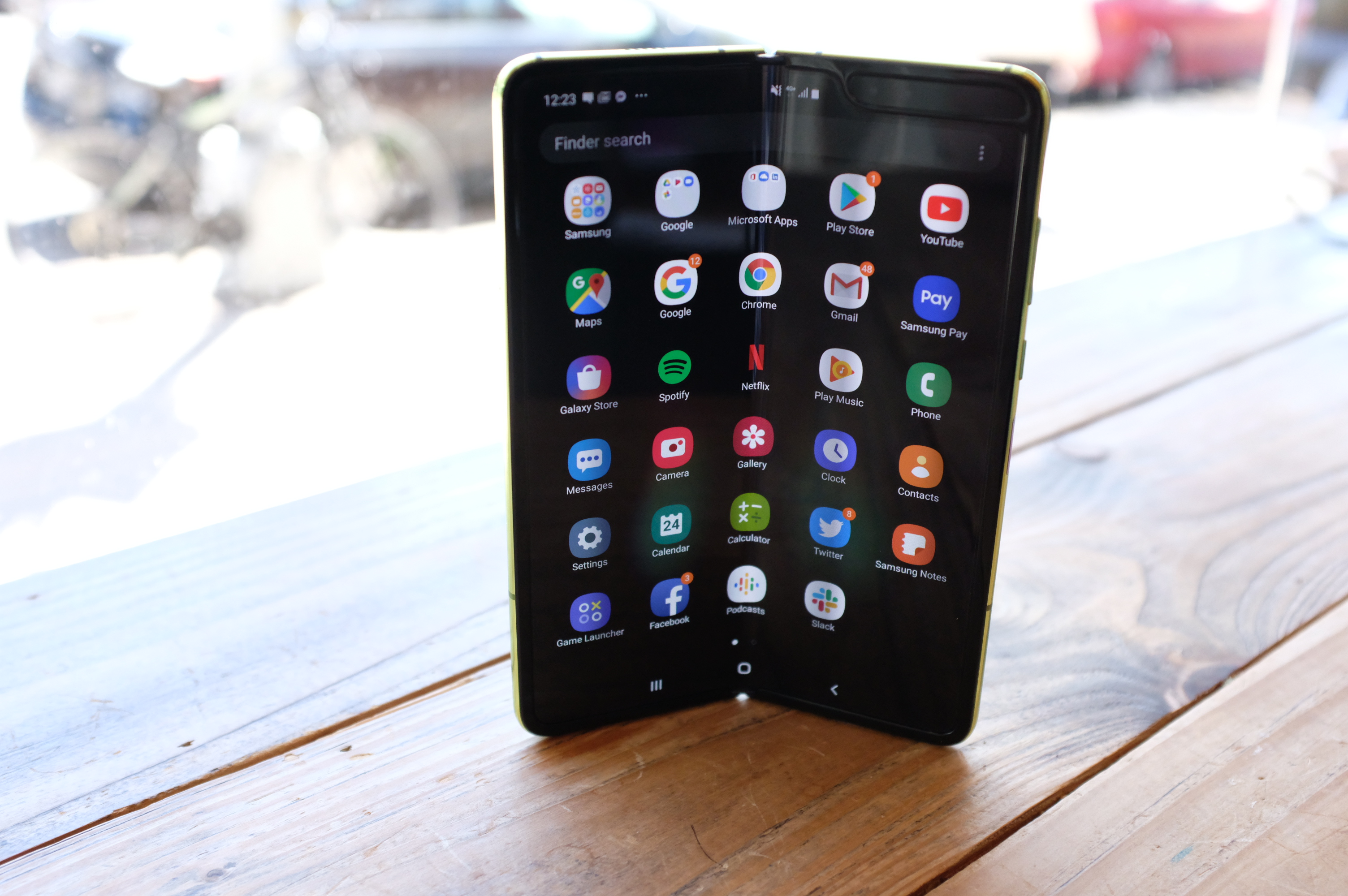
And the seam. I found myself uttering the phrase “it could be worse” a lot. Like so much of the general aesthetic (including the odd green-gold color of my Fold’s casing), it’s lighting-dependent. There are plenty of times when you don’t see it all, and other when the glare hits it and makes it look like a line right down the center.
I realized after snapping a couple of photos that it’s particularly apparent in many shots. That probably gives a false impression of its prominence. It sucks that there’s one at all, but it’s not a surprise, given the nature of the design. You mostly don’t notice it, until your finger swipes across it. And even then it’s subtle and totally not a dealbreaker, unlike, say, the massive gap that made the ZTE Axon M look like two phones pasted together.
I love the ability to stand the device up by having it open at a 90-degree angle, so I can watch videos while brushing my teeth. But this orientation blocks the bottom speakers, hampering the already iffy sound. Thankfully, your $1,980 will get you a pair of the excellent Galaxy Buds in box. It’s hard to imagine Apple bundling AirPods with the next iPhone, but I guess stranger things have happened, right?
Multi-Active Window is the other key software piece. It’s something that has been available on other Samsung devices and certainly makes sense here. Open an app, swipe left from the right side of the screen and a tray will open. From there, you can open up to three apps on the display. Once open, the windows feature a small tab at the top that lets you rearrange them.
It’s handy. I used it the most during those times I had a video playing on an exercise machine, so I didn’t have to close out of everything to check emails and Twitter. I’m a gym multi-tasker. I’m sorry, it’s just who I am now.
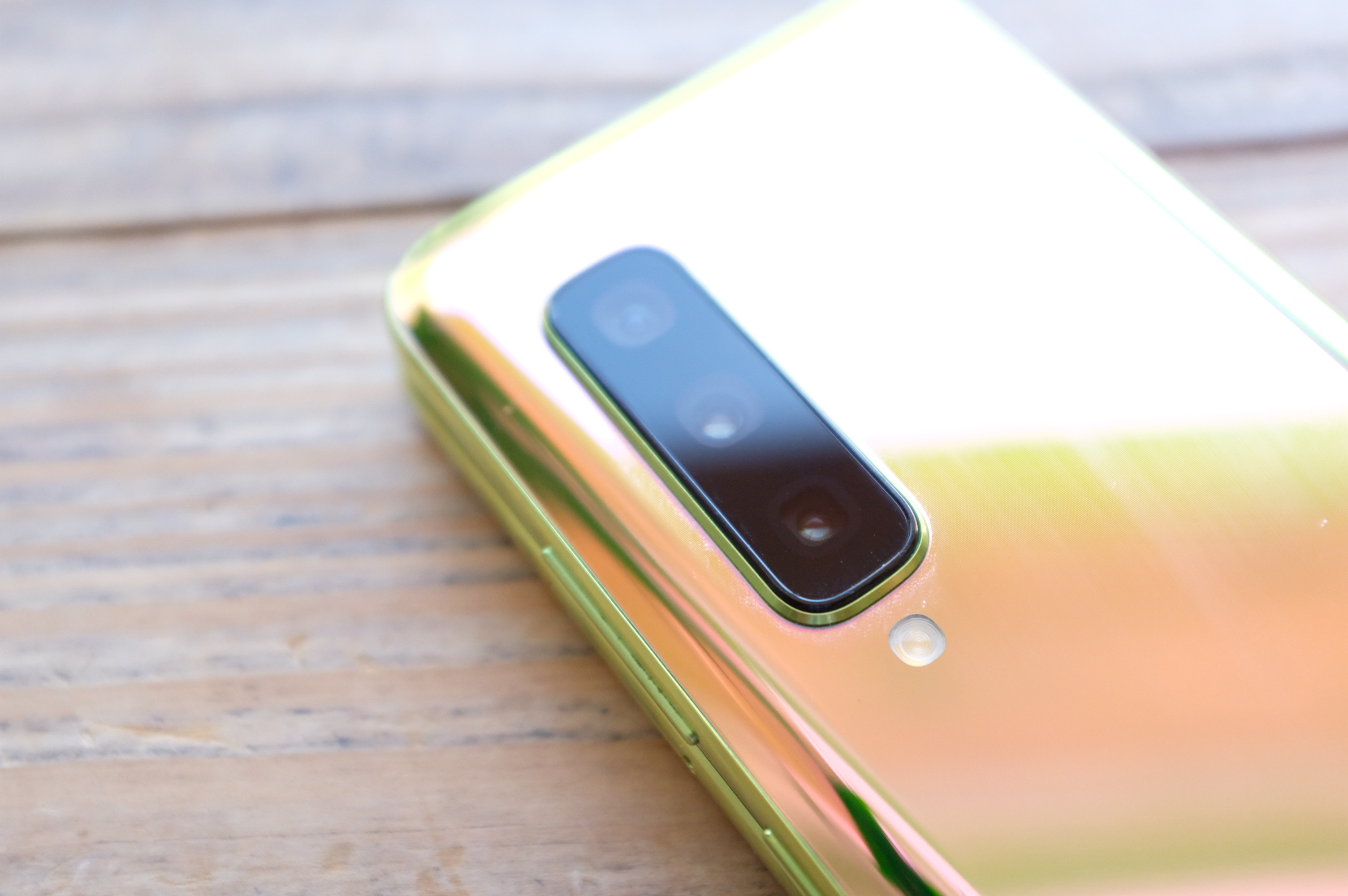
It worked quite well on the whole, courtesy of robust internals, including 12GB of RAM and a Snapdragon 855. The primary issue I ran into was how some of the apps maintained that half-screen format after I closed out and reopened. I’m sure some people will prefer that, and I’m honestly not sure what the ideal solution is there.
The Fold’s also got a beefy battery on board. Like Huawei’s, it’s split in two — one on either side of the fold. They work out to a beefy 4,380 mAh. That’s just slightly less than Huawei’s 4,500, but again, the Mate X is 5G by default — which means it’s going to burn through mAhs at a faster rate.
Ultimately, the Fold’s greatest strength is Samsung itself. I understand why you probably just did a double take there in the wake of the company’s latest hardware scandal, but the fact is that the company knows how to build phones. The Fold was very much built atop the foundation of the successful Galaxy line, even while it presents a curious little fork in the family tree.
That means a solid and well-thought-out user experience outside of the whole fold thing.
[gallery ids=“1816871,1816872,1816873,1816874,1816875,1816876”]
That list includes great cameras with excellent software features and clever tricks like the new Wireless PowerShare, which lets you fold up the phone and charge up those Galaxy Buds or another phone while it’s plugged in. For better or worse, it also includes Bixby. Our model was a European version that didn’t have the full version, but I think I’ve made my thoughts on the smart assistant pretty well known over the last couple of years.
The devoted Bixby button is very much here. And yes, I very much accidentally pressed it a whole bunch. The headphone jack, on the other hand, is conspicuously absent, which is no doubt a big driver behind the decision to include Galaxy Buds. The Fold is an anomaly in a number of ways, but it’s hard to shake the feeling that this might finally represent the beginning of the end for the port on Samsung’s premium devices.
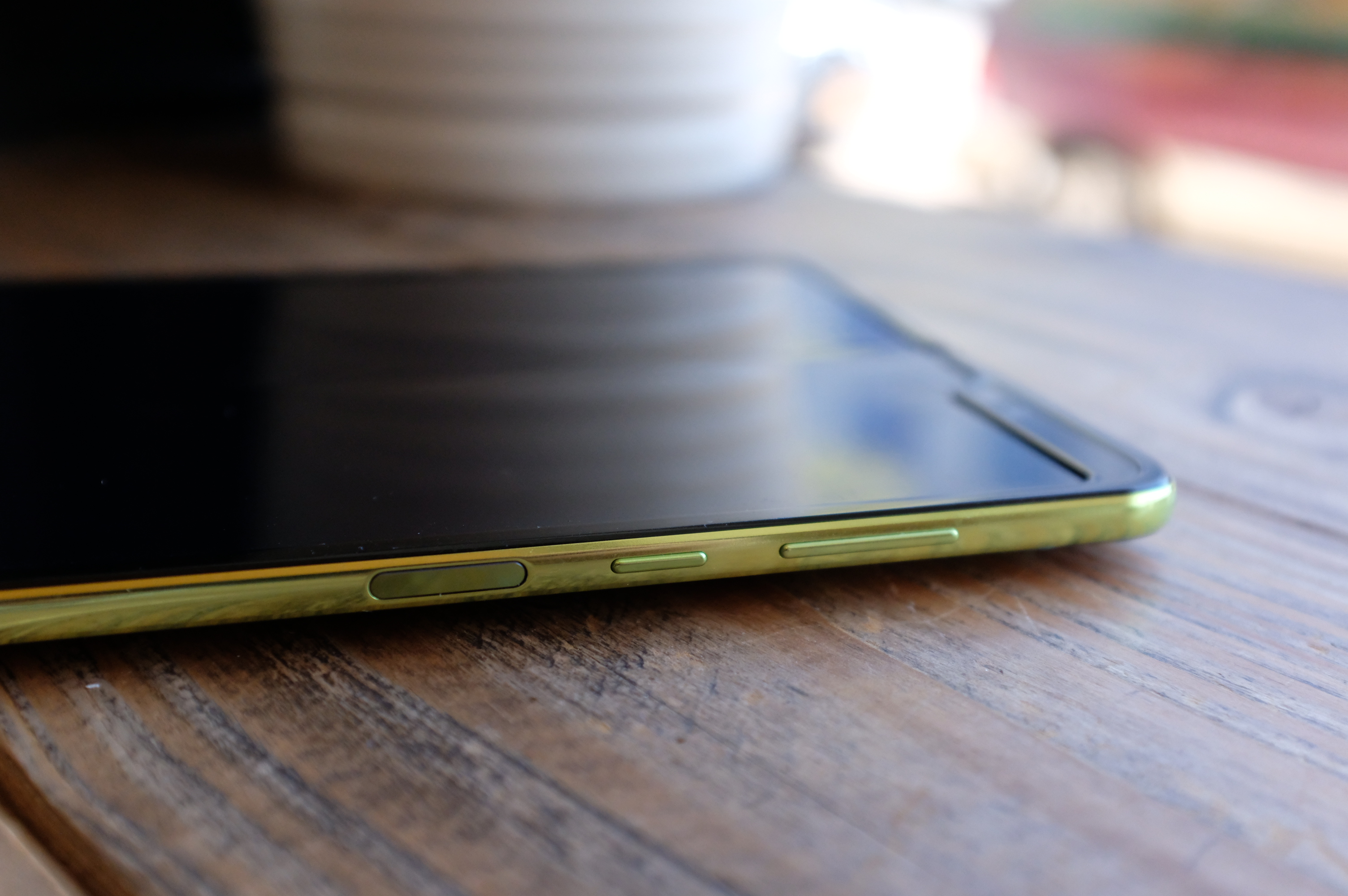
Also absent is the S Pen. The stylus began life on the Note line and has since branched out to other Samsung devices. I suspect the company would have had a tough time squeezing in space for it alongside the dual batteries, and maybe it’s saving something for future generations, but this does feel like the ideal screen size for that accessory.
I’m parting ways with the Fold this week, per Samsung’s instructions. Unlike other products, giving it up won’t feel that tough. There wasn’t a point in the past week when the Fold didn’t feel like overkill. There were, however, times when my iPhone XS screen felt downright tiny after switching back.
In many ways, the foldable phone still feels like the future, and the Fold feels like a stop along the way. There are a lot of first-gen issues that should be/should have been hammered out before mass producing this device. That said, there are certain aspects that can only really be figured out in real-world testing. Take the fact that Samsung subjected the device to 200,000 mechanical open and closes. That’s a lot, and probably more than the life of just about any of these devices, but people don’t open and close like machines. And when it comes to the screen, well, a little dirt is bound to get between the gears, both metaphorically and literally.
As I close this Galaxy Fold a final time, it seems safe to say that the device represents a potentially exciting future for a stagnant smartphone space. But that’s the thing about the future — it’s just not here yet.
from RSSMix.com Mix ID 8176981 https://techcrunch.com/2019/04/24/samsung-galaxy-fold-review-future-shock/
http://www.gadgetscompared.com
from Tumblr https://ikonografico.tumblr.com/post/184423790601
via http://www.gadgetscompared.com
Facebook reserves $3B for FTC fine, but keeps growing with 2.38B users in Q1
A massive penalty hangs over Facebook’s head, but it otherwise had a very strong Q1 earnings report. Facebook reached 2.38 billion monthly users, up 2.5 percent from 2.32 billion in Q4 2018 when it grew 2.2 percent, and it now has 1.56 billion daily active users, up 2.63 percent from 1.52 billion last quarter when it grew 2 percent. Facebook pulled in $15.08 in revenue, up 26 percent year-over-year compared to Refinitiv’s consensus estimates of $14.98 billion in revenue.
Facebook recorded earnings per share of $0.85 compared to estimates of $1.63 EPS. However, that’s because Facebook has set aside $3 billion to cover a potential FTC fine that it’s still resolving. Without that fine, it would have had an EPS of $1.89. Despite the set-aside, Facebook still earned $2.429 billion in profit, though that’s down from $4.988 a year ago and $6.8 billion in Q4 2018.
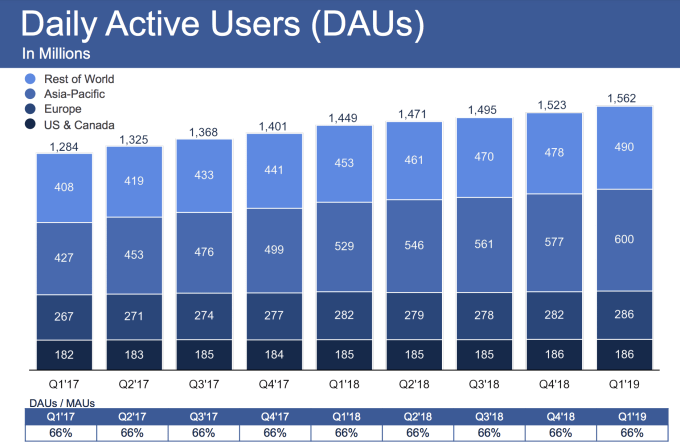
Facebook’s share price rose 8.3 percent to $197.84 after closing before earnings at $182.58, way up from its recent low of $124.06 in December. Wall Street seems to have already priced in the potential FTC fine. Facebook has agreed to strict oversight of how it handled user privacy in a 2011 deal with the FTC. It promised to not misrepresent its privacy practices or change privacy controls without user permission, and it’s now negotiating the fine for potentially breaking those terms.
Facebook wrote in its earnings release about the FTC fine that:
“In the first quarter of 2019, we reasonably estimated a probable loss and recorded an accrual of $3.0 billion in connection with the inquiry of the FTC into our platform and user data practices, which accrual is included in accrued expenses and other current liabilities on our condensed consolidated balance sheet. We estimate that the range of loss in this matter is $3.0 billion to $5.0 billion. The matter remains unresolved, and there can be no assurance as to the timing or the terms of any final outcome.”
It’s possible Facebook escapes with a lesser fine that would likely still dwarf Google’s $22.5 million penalty for violating an FTC privacy deal. But it also might have to drag down a future quarter of earnings if the fine ranges as high as $5 billion or larger. Though Facebook does have $45.2 billion in cash and securities on hand to pay that fine and make any necessary acquisitions. Facebook’s headcount grew 36% year-over-year to 37,773 as it staffs up its security team, but it still has a 22 percent operating margin.
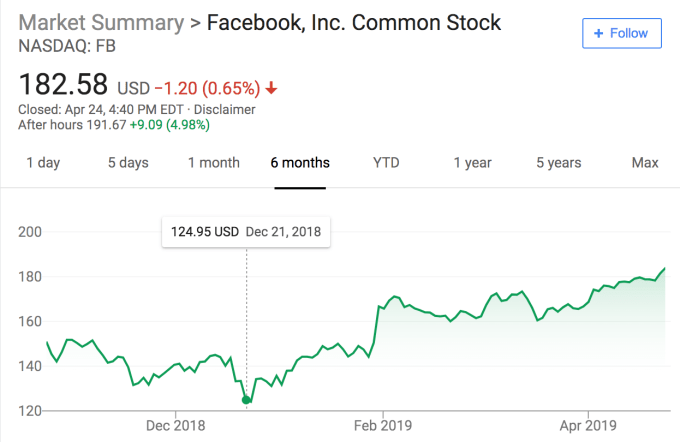
Facebook has managed to hold on to its 66 percent daily to monthly user ratio, showing people aren’t necessarily using it less despite all the backlash. It added 39 million daily users, compared to Snapchat’s addition of 4 million in Q1. But Facebook failed to grow past its 186 million daily user count in the US & Canada where it got stuck last quarter, but at least it added 4 million in its lucrative Europe market, plus it had atypically large gains in Asia-Pacific and the Rest Of World regions. As for monetization, Facebook made modest gains in average revenue per user across markets compared to Q3 2018 (excluding the holiday-laden Q4). Europe did especially well, growing ARPU 8.2 percent.
Zooming out, Facebook now has over 2.7 billion total mothly users across its family of Facebook, Messenger, Instagram, and WhatsApp, the same as last quarter. 2.1 billion people use at least one of those apps daily, up from 2 billion last quarter. Instagram Stories, WhatsApp Status, and Facebook Stories on Facebook and Messenger combined each now have 500 million daily users. Facebook also now has 3 million advertisers buying Stories ads across its apps, so the ephemeral format will likely start to contribute meaningful revenue soon.
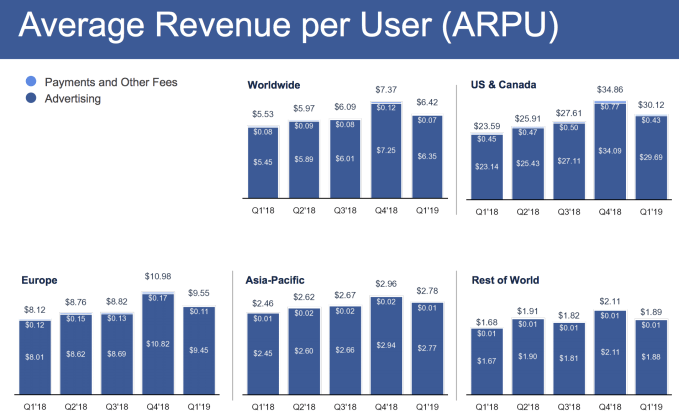
Color From The Earnings Call
In March, Zuckerberg announced plans for a massive privacy-centric overhaul of Facebook to turn it from just a townsquare into also a “living room”. That means unifying its messaging apps with a backend that supports end-to-end encryption, and promoting ephemerality in content sharing and communication. That could help deter calls for regulation, make Facebook harder to break up, and help it stay ahead of competitors like Snapchat, but will also be a massive product and engineering undertaking.
Today, Zuckerberg focused on providing more details to this plan to expand privacy, encryption, impermanence, safety, interoperability, and secure data storage. He stressed that given people traditionally spend more time communicating and consuming content privately than publicly, strengthening Facebook’s “living room” could boost its business. Zuckerberg noted that since Facebook already doesn’t use messaging content for ad targeting and recent content is more useful for its business, encryption and impermanence shouldn’t be a big risk either. Refusing to store data in countries with poor records of privacy could lead to Facebook being banned there, which Zuckerberg admitted is a major business threat, but one it’s grappled with over content policies for years.
In fact, impermanence is already earning money for Facebook. It said that Instagram Stories was the greatest contributor of additional ad impressions this quarter. And while the Facebook and Instagram feeds are already jammed full of ads with little room for more, Facebook says there’s still room to significantly increase Instagram Stories ad load.
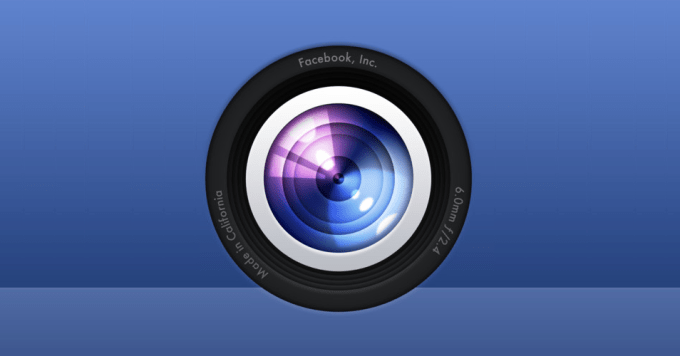
Another highlight of the call was Zuckerberg’s discussion of Facebook’s payments strategy. He confirmed that Facebook plans to build out ways for people to pay merchants through its messaging apps. “So I think that what we’re going to end up seeing is building out payments, which is going to end up being something that we do country by country … The goal is to have something where you could do discovery through the broader townsquare-like platforms like Instagram and Facebook, and then you can complete the transactions and follow up with businesses individually and have an ongoing relationship through Messenger and WhatsApp.”
This is the first earnings report of a full quarter following Facebook’s worst-ever security breach in September that impacted 50 million users, shaking confidence in the social network’s privacy and security. It’s also the first full quarter in which Facebook sold its own branded hardware — its Portal video chat device that was well received by critics except for the fact that it was made by Facebook.
Yet the defining story continues to be Facebook’s struggle with claims that its user research and developer platform efforts endangered user privacy and steamrolled competitors in search of growth. That includes TechCrunch’s big scoop that Facebook was paying teens to snoop on their data with a VPN app, which eventually led Facebook to shut down its Onavo user surveillance apps. The fact that Facebook isn’t losing massive numbers of users after years of sustained scandals is a testament to how deeply it’s woven itself into people’s lives.
from RSSMix.com Mix ID 8176981 https://techcrunch.com/2019/04/24/facebook-earnings-q1-2019/
http://www.gadgetscompared.com
from Tumblr https://ikonografico.tumblr.com/post/184423790346
via http://www.gadgetscompared.com
